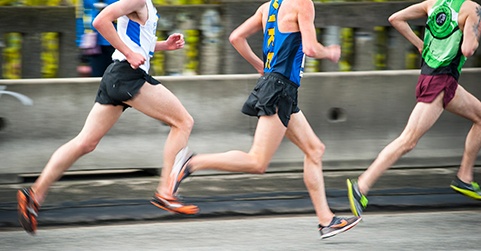
When running, each foot comes into contact with the ground 80 to 100 times per minute on average. In addition to that, studies show between 50 and 80 percent of runners are injured every year from overuse injuries associated with repetitive force being applied to feet and legs.
However, foot-strike patterns are variable, and the specific interaction between the foot and the ground is influenced by multiple factors like speed, surface and footwear. The minimalist movement of the last few years has gotten runners focused on their feet, specifically looking at whether their choice of footwear could improve injury rate and/or performance.
I'll admit, I was intrigued and experimented with different shoes to improve my injury rate and performance. I also did some research.
However, I've found that despite shoe preference or choice, there's a general lack of consensus on just what one's feet should be doing while one is running.
Yes, there is a distinct difference between heel-striking, mid-foot-striking and running on your forefoot. Various studies support the pros and cons of each style.
"Read also: Detecting Your Foot Strike"
But physical therapist Jay Dicharry, one of the country’s leading running gait analysts and running injury experts says the way to reduce the chance for injuries is to run with the least possible musculoskeletal stress on your system possible with the least metabolic cost.
Personally, I like this approach. Rather than try to find a shoe to "correct" my running form - which had developed organically based on my individual biomechanics - I'd rather understand it and use what I know to achieve the optimal efficiency.
Sensoria Fitness Socks (not shoes!) allow me to do just that! Understand my foot strike cadence and patterns. This is invaluable info that has let me optimize my performance without risking different musculoskeletal injury. Instead of trying to force my mechanics to change by wearing a certain shoe. These socks give me the information I need to be able to consciously work on my own form and mechanics. Give them a try and see what you can learn about your foot strike and cadence.

Then, use this method to safely tinker with your mechanics to improve your form:
- Start by shortening stride length. It will help bring your foot-strikes closer to your body, and the majority of your weight will land directly under you - where is has the most skeletal support. “The most important thing is that you want your feet to land as close to your body for a given pace as possible,” says Dicharry.
- It is also important to land effectively, meaning place your foot on the ground rather than simply dropping it down. Having your foot downward in a slight pawing move will help reduce the shock upon impact.
- Lastly, pay attention to your shins. Whether you are a mid-foot or heel striker, if your shins are rearward upon landing, you are putting on the breaks. When trying to ultimately move forward with the greatest ease and comfort this can be detrimental.
I hope these tips help. I encourage everyone to try a pair of Sensoria Fitness Socks. I am always much more conscious of my form, foot strike and cadence when they are on. And I know the more frequently I wear them, eventually the good form will become second nature and my injuries will be reduced whether I am in my racing flats or in trail shoes.
